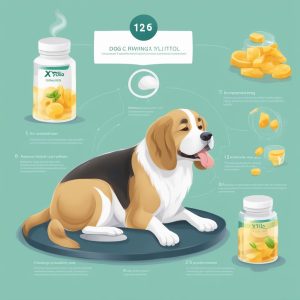Is Xylitol Poisonous for Dogs? Understanding the Risks and Symptoms

Xylitol is commonly used as a sugar substitute in many sugar-free products, ranging from chewing gum to baked goods. While it offers dental and diabetic benefits for humans, its effects on dogs can be lethal. Understanding the dangers that xylitol poses to dogs is crucial for any pet owner. If your dog ingests xylitol, the consequences can range from a rapid decrease in blood sugar levels to possible liver failure, and in severe cases, it can be fatal.
Knowing what products contain xylitol and keeping them out of reach of your pets is essential for their safety. It’s also important to be aware of the symptoms of xylitol poisoning, which include weakness, vomiting, and seizures, so that you can act quickly. Prompt veterinary attention is vital if xylitol ingestion is suspected, as early intervention can be life-saving.
Key Takeaways
- Xylitol ingestion can lead to severe, often life-threatening conditions in dogs.
- Swift veterinary intervention is critical if your dog consumes xylitol.
- Preventative measures are key in keeping your dog safe from xylitol poisoning.
Xylitol Toxicity in Dogs
Xylitol poses a severe risk to your dog’s health, potentially causing life-threatening conditions such as hypoglycemia and liver failure. Quick recognition and response are crucial for the best outcome.
Sources of Xylitol
You’ll find xylitol in numerous household products, many labeled as sugar-free or no sugar added. This sugar alcohol is commonly present in sugar-free gum, toothpaste, nut butters, and a variety of sugar-free products such as mints, candies, and even some dietary supplements. Be cautious with baked goods, syrups, and desserts like yogurt or pudding, as these may also contain xylitol.
Effects of Xylitol on Dogs
When dogs consume xylitol, their bodies mistakenly release insulin, leading to a dangerous drop in blood sugar levels. Hypoglycemia can occur rapidly, typically within 10 to 60 minutes, and prolonged hypoglycemia may lead to liver injury or liver failure. In severe cases, death can occur.
Clinical Signs and Diagnosis
The clinical signs of xylitol poisoning include vomiting, weakness, collapse, shaking, lack of coordination, and seizures. If you notice these symptoms or suspect xylitol ingestion, consult your veterinarian or contact poison control immediately. Diagnosis may involve measuring blood glucose levels and assessing for hypokalemia and hepatic necrosis.
Treatment and Management
Immediate treatment is essential. Expect your veterinarian to initiate decontamination like inducing vomiting or administering activated charcoal. Intravenous fluids and intravenous dextrose are often necessary to manage hypoglycemia. Your dog may need to be hospitalized for monitoring and supportive care. With prompt treatment, the prognosis can improve, but without quick intervention, the risk of serious complications or death rises significantly.
Preventing Xylitol Poisoning
Protecting your dogs from xylitol poisoning involves vigilance and education. Know which products contain this toxic sugar substitute and how to keep them out of your pet’s reach.
Identifying Dangerous Products
Examine labels and ingredient lists for xylitol, also known as birch sugar, wood sugar, or sugar alcohol. It’s a common food additive in items like chewing gum, chewable vitamins, and cosmetics. Be cautious of pharmaceuticals, mouthwash, and even some types of human toothpaste. Despite its presence in nasal sprays and sugar-free products, xylitol remains hazardous to dogs.
Pet Owners’ Responsibilities
Ensure safety by keeping products containing xylitol secured and away from where your pet can access them. This includes places like purses or low shelves. Maintain awareness of the signs of xylitol poisoning and have contact information for your veterinarian, the Pet Poison Helpline, and the animal poison control center. In case of accidental ingestion, immediate action can save your pet’s life.
Alternative Options and Considerations
Consider alternative options that are safe for pets, and always monitor when new types of products are brought into your home. Educate your family and friends about the dangers of xylitol to ensure they are also cautious about what they bring into environments your pets can access. Remember, while xylitol is safe for humans, it can cause severe issues, including hypoglycemia, in dogs. Other pets like cats and ferrets may also be at risk.
Frequently Asked Questions
In this section, you’ll find concise answers to commonly asked questions about xylitol poisoning in dogs, including symptoms, timeframes for toxicity manifestation, toxicity levels, and common household items that are potential sources of xylitol.
What are the symptoms of xylitol poisoning in dogs?
If your dog has ingested xylitol, symptoms may include vomiting, weakness, lack of coordination, seizures, and coma. These are signs of a sudden drop in your dog’s blood sugar or potential liver failure.
How long does it take for xylitol poisoning to manifest in dogs?
The onset of xylitol poisoning symptoms can be rapid, often occurring within 30 minutes of ingestion. Monitoring your dog closely during this period is critical for their safety and health.
What is the toxicity level of xylitol for canines?
The toxicity threshold for xylitol in dogs is quite low; ingestion of more than 0.1 grams per kilogram of body weight can lead to hypoglycemia. Doses above 0.5 grams per kilogram can result in acute liver failure.
Which common household products contain xylitol that could be harmful to dogs?
Products such as sugar-free gum, mints, certain brands of peanut butter, and baked goods may contain xylitol. Always check the ingredients list to ensure your dog’s safety.
Can a dog survive after ingesting xylitol, and what is the prognosis?
Survival is possible if you act swiftly. Prognosis after xylitol ingestion largely depends on the amount ingested and how quickly treatment begins. Immediate veterinary care is essential.
Are there specific peanut butter brands without xylitol that are safe for dogs?
Yes, many peanut butter brands are xylitol-free and thus safer for canine consumption. However, always verify by reading the ingredient label to ensure that xylitol is not present.
